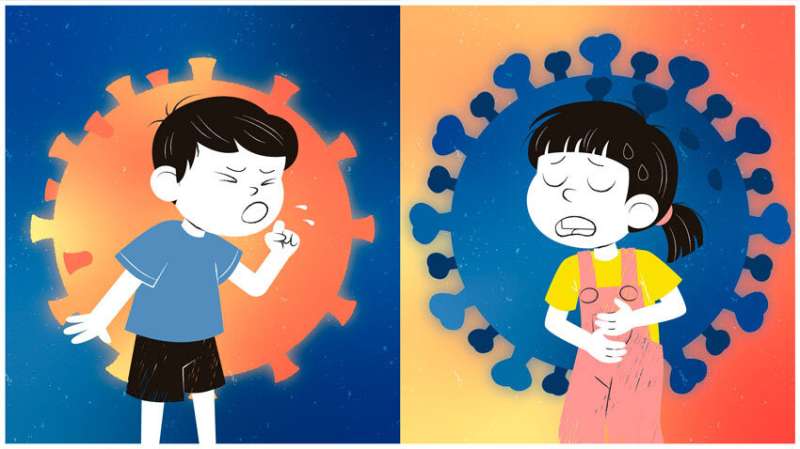

Flu and COVID-19 symptoms can look similar in kids—both are known to cause fever, coughing and fatigue and prompt parents to keep children home from school.
And while rare, the chance of either virus leading to critical illness in children may also be similar, suggests research by a team of pediatric intensive care researchers.
One in three children in a multi-hospital cohort who was admitted to the pediatric intensive care unit for either COVID-19 or influenza required mechanical ventilation, according to the study in Clinical Infectious Diseases conducted by the multi-hospital Pediatric Intensive Care Influenza (PICFLU) network’s Overcoming COVID-19 Investigators team.
About 16% of flu patients and 9% of COVID patients also had a secondary bacterial infection.
“Critically ill children with either virus have comparable outcomes in terms of needing breathing support or blood pressure medicines to treat shock,” said Heidi Flori, M.D., F.A.A.P., pediatric intensivist at University of Michigan Health C.S. Mott Children’s Hospital and a member of PICFLU and Overcoming COVID-19 Investigators team.
Vaccines can protect children
Flori says the data reinforces the importance of taking steps to protect children from both infections through vaccines, especially as the new school season begins.
“Whether it’s flu or COVID, there seems to be a general public perception that neither cause serious illness in kids,” she said.
“But for those of us working in pediatric ICU care, we’ve seen infections lead to critical illness and sometimes death in young people. Vaccinations are the best tools we have.”
Researchers compared 179 children with influenza infection to 381 with COVID-19 at 16 United States hospitals. Patients with critical COVID-19 stayed longer in the PICU than kids with critical influenza and mortality was low (2-3%) but similar in both groups.
The study—led by Natasha Halasa, M.D., pediatric infectious diseases expert at Vanderbilt University Medical Center—also suggests slight differences in the viruses’ impact on different age and demographic groups.
Children hospitalized with COVID-19 were generally older than those with influenza. Almost half of the children with flu were between eight months old to under age five while more than four fifths of those with COVID-19 were aged 5–17—of which more than half comprised the oldest age group, 13–17 years.
Two thirds of children in the study hospitalized with influenza or COVID-19 also had an underlying medical condition but a third were otherwise healthy. Respiratory conditions were the most common underlying condition in both groups.
Health disparities in both younger and older age groups
About half of the children with critical influenza and a fourth with COVID-19 were white. In comparison, about 40% of children with influenza and over two thirds of those with COVID-19 were Black or Hispanic.
“Our data suggests that the health disparities we saw in the older age groups with COVID may exist among younger patients as well,” Flori said.
The study excluded 850 children who were diagnosed with a rare but serious COVID-linked condition called multi-system inflammatory syndrome, or MIS-C.
MIS-C, which causes severe inflammation in vital organs and tissues, has been linked to more than 8,000 pediatric cases and 70 deaths across the country. Children with the condition were separated in this specific research because MIS-C is considered a post-acute infection, says Flori, who notes the network has focused other studies specifically on MIS-C.
While rare, even healthy kids can end up in the ICU from flu or COVID
Each year, millions of children get sick with seasonal flu. Annual flu-related hospitalizations among U.S. children younger than five have ranged from 7,000 to 26,000 between 2010 to 2020, according to the Centers for Disease Control and Prevention. While relatively rare, some children also die from flu each year—the CDC reports a range of 37 to 199 deaths during regular flu seasons between 2004 and 2020.
During the omicron dominant period of COVID-19 (December 2021–February 2022), COVID-19–associated hospitalization rates in children aged 5–11 years were also nearly twice as high among unvaccinated as among vaccinated children, according to the CDC.
Flori says because the longtime PICFLU network was already in place to pool data across peer hospitals to analyze critical illness in kids from flu, the group was well positioned to do the same work for COVID-19 when the pandemic hit.
“While there are relatively low numbers of severe illness and death in kids from both flu and COVID, it’s not zero,” she said. “Kids do get very sick and there are deaths every year from infections that cause hospitalizations and other long term health risks.
Source: Read Full Article